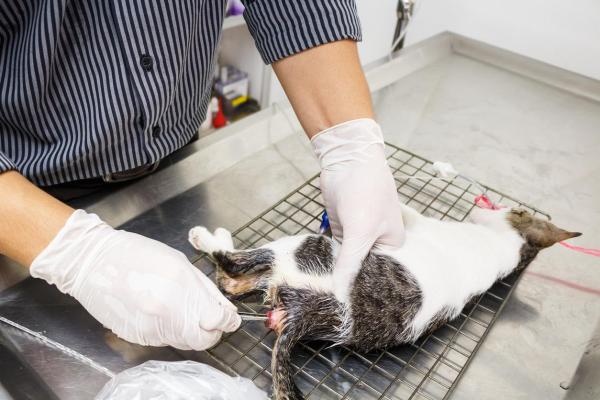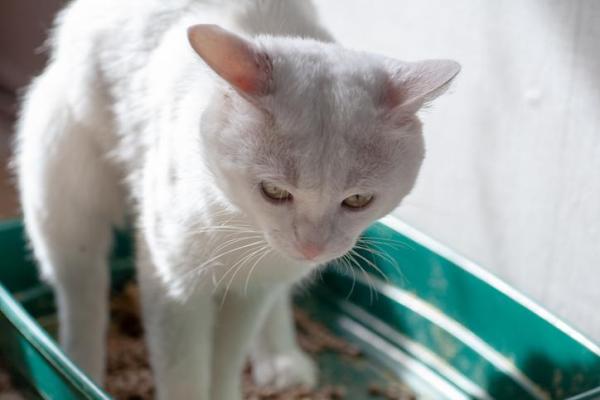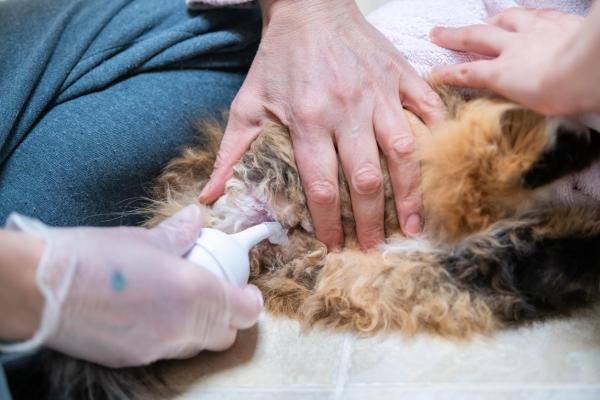
Gastrointestinal disorders are commonplace with cats. Whether caused by physical or psychological stimuli, a cat can have various digestive symptoms which point to a problem with their health. These problems may pass after time or when the underlying cause has been treated. Sometimes more chronic symptoms can be observed, especially with serious pathological, congenital or idiopathic health problems. When constipation is prolonged, veterinarians will consider the possibility of megacolon. This is a symptom which results in the abnormal dilation of the large intestine and its repercussions can be severe.
At AnimalWised, we explain more about megacolon in cats. We help to understand the causes, symptoms and treatment of this problem if you fear it may be affecting your feline.
What is megacolon in cats?
Megacolon in cats is defined as severe and irreversible dilatation of the colon. The result is fecal retention and hypomotility, resulting in constipation. The large intestine's shape and size is a vital component of healthy stool. When the colon is too large after dilation, feces can accumulate and harden, making it very difficult for peristalsis to be carried out and allow normal passage of feces through the gastrointestinal tract.
Intestinal transit in cats can last between 12 and 24 hours from ingestion of a substance to its evacuation as feces. When this process is prolonged, it can have various adverse effects. The large intestine extracts water from the stool to solidify it for excretion. When stool retention occurs over a significant enough amount of time, the colon still extracts the water causing it to compact and harden. This is what leads to constipation and chronic cases can lead to severe dilation of the intestine and megacolon.
When we see our cat has constipation for any significant length of time, we need to find the reason. Chronic constipation can lead to megacolon and the resulting symptoms we detail further below.
Causes of megacolon in cats
The majority of cases of megacolon in cats (around 62%) are idiopathic, meaning, they have no apparent cause. This is followed by obstructive cases of the colon (24%), those caused by neurological damage (11%), congenital causes or as a side effect of other problems which result in chronic constipation in the cat.
Idiopathic megacolon in cats
This type of feline megacolon occurs most frequently in elderly male cats over 8 years of age in which no organic lesion is found. It is believed that it may be due to a primary neuromuscular degeneration of the smooth muscle of the colon. This causes chronic constipation and subsequent megacolon. It is diagnosed by exclusion of other causes.
Megacolon in cats due to obstructive causes
Megacolon in cats can be caused by processes that trigger obstruction in the colon and make fecal evacuation difficult. Some pathologies that can cause this are the following:
- Pelvic canal stenosis secondary to fractures
- Pelvic canal stenosis secondary to diseases such as rickets
- Traumatic stenosis or intraluminal mass in the colon, rectum or anus
- Extraluminal compression due to neoplasia or perineal hernia
- Spinal injuries (e.g. cauda equina syndrome)
Megacolon in cats due to neurological damage
In some cases, neurological damage can cause hypomotility of the colon, fecal retention, dilatation of the colon and the development of megacolon. These causes can include:
- Neuromuscular alteration due to trauma at the sacro-coccygeal level
- Alteration in the pelvic and hypogastric nerve due to trauma or dysautonomia
Congenital megacolon in cats
Sometimes megacolon can present in kittens, despite having a good level of basic care. In these cases, fecal retention in kittens is usually caused by the following congenital diseases:
- Anorectal agenesis
- Aganglionosis (absence of neurons that inhibit contraction, resulting in permanent contraction of the smooth muscle of the colon or rectum, resulting in obstruction and megacolon)
- Partial or complete absence of the caudal and sacral spinal segment, something common in the Manx cat
Megacolon in cats due to chronic constipation
Finally, megacolon can be caused by chronic constipation due to:
- Stress/fear due to moving, renovations, introduction of other animals, changes in the litter, hospitalization, inactivity or aversion to the litter tray. Learn more with our article on the symptoms of stress in cats.
- Joint pain that causes difficulty defecating or in the rectum or perineal area.
- Colonic stenosis due to foreign body, neoplasia, perineal hernia, rectal diverticulum or pelvic fractures, neoplasia, prostate diseases, neoplasia or granuloma.
It is important to note the difference between basic constipation and megacolon. Read more with our article on why a cat hasn't pooped in 4 days.
Symptoms of megacolon in cats
Cats with megacolon present symptoms related to constipation, as well as other clinical signs. The symptoms of megacolon in cats include:
- Painful defecation attempts (usually manifested in painful meowing) and presence of tenesmus (sensation of need to defecate)
- Prolonged constipation over time (chronic)
- Defecating outside of the litter box due to the pain associated with constipation when using it
- Secretion of bloody liquid content due to irritation of the colonic mucosa
- Ptyalism (excessive salivation)
- Severe vomiting due to irritation of the colon and absorption of toxins through the colon
- Anorexia, lethargy and weakness
- Dehydration
- Electrolyte imbalances
- Hard tubular mass throughout the abdomen
- Sometimes diarrhea, sometimes with blood and/or mucus
Some of these symptoms infer the cat's health is seriously affected. Learn more with our article on blood in a cat's feces.

Diagnosis of megacolon in cats
Megacolon should be diagnosed through the use of various diagnostic tests. This will begin with assessing their medical history and performing a physical examination. This will look at their general health, hydration status, body condition and mental status. This will help point in the direction of the possible cause or causes that are producing this chronic constipation due to megacolon. A complete blood and urine analysis will be necessary.
The diagnostic technique of choice for diagnosing a case of megacolon in cats is abdominal radiography. Pelvic canal strictures and masses can also be ruled out with this imaging technique. With radiography it can also be differentiated from severe chronic constipation by comparing the relationship between the thickness of the colon and the length of the body of the L5:
- A ratio <1.28 is an indicator of a normal colon
- A ratio between 1.28-1.48 suggests constipation
- A ratio >1.48 is a good indicator of megacolon
- A ratio >1.6 is confirmed diagnostic of megacolon
Other imaging techniques useful for its diagnosis can be abdominal ultrasound, colonoscopy, and magnetic resonance imaging (MRI), especially for cases of obstructive megacolon.

Treatment for megacolon in cats
The treatment of a feline megacolon must combine medical therapy with a specific diet. Drugs and products that facilitate the passage of feces will be used, but in advanced cases surgical treatment will be necessary.
Diet for cats with megacolon
The diet for a cat with megacolon should be high in moisture by increasing the water content in the diet. This will be doing by using wet food, provided high-moisture content snacks such as milk for adult cats or using feline soups, as well as adding water to dry cat feed.
It can also be a good option to add insoluble fibers such as Pysillium which increase the water content of the stool and frequency of defecation. However, they add bulk to the feces, which can be detrimental to an already damaged colon, so they should only be given early in the disease and in well-hydrated cats.
Medical treatment of cats with megacolon
If you are wondering how to treat megacolon in cats, you should know that a specialist must be the one who prescribes the appropriate medications. When diet is not sufficient to treat megacolon, the medical approach usually consists of the use of the following groups of drugs:
- Laxatives: added when diet modification is not enough. Lactulose can be used at a dose of 0.5 ml/kg every 8-12 hours, macrogol (polyethylene glycol 3350) at a dose of 1/8 to 1/4 teaspoon every 12 hours on food, or bisacodyl at a dose of 5 mg/24 hours orally. They stimulate mucosal secretion and colonic contractility, but continued use can damage enteric neurons.
- Prokinetics: ranitidine can help, but only once the accumulation of feces is corrected to stimulate colonic motility.
- Enemas: to facilitate the elimination of feces through the introduction of liquids that facilitate it, such as 5 ml of lauryl sulfoacetate or bisacodyl in mild cases. If the case is severe, enemas should be applied through a well-lubricated 10-12 French enema tube of warm water (5-10 ml/kg) with mild soap or mineral oil (5-10 ml/cat) or lactulose (5-10 ml/cat).
- Manual extraction: this procedure will only be performed in very severe cases and always with the cat generally anesthetized and hydrated. After the administration of an enema, the stool is manipulated through the abdominal wall or through the rectum. This can damage the mucosa of the colon with the increased risk of absorption of toxins and bacteria into the blood, so prophylactic antibiotics should always be administered.
Surgical treatment of feline megacolon
When the cat suffers from recurrent megacolon, a surgery called ‘subtotal colectomy’ can be performed, which consists of removing between 95-85% of the colon. It generally has good prognosis. Stools may be liquid at first after surgery, but improve in 1 to 6 weeks if they do not have other conditions that cause diarrhea, such as small intestinal bacterial overgrowth (SIBO) or inflammatory bowel disease (IBD).
This article is purely informative. AnimalWised does not have the authority to prescribe any veterinary treatment or create a diagnosis. We invite you to take your pet to the veterinarian if they are suffering from any condition or pain.
If you want to read similar articles to Megacolon in Cats - Symptoms and Treatment, we recommend you visit our Intestinal problems category.
- Bertoy, R. W. (2004). Megacolon in the cat. Retrieved from: https://www.ncbi.nlm.nih.gov/pubmed/12148317
- Aybar, V., et al. (2018). Clinical Manual of Feline Medicine. Ed. SM Publishing LTD. Sheffield, UK.